This was published 3 years ago
‘She loved to embarrass people’: William Mora on his mum, Mirka
With renowned artist Mirka as a mother and Georges, a gallerist, as a father, it’s not surprising the Mora offspring pursued careers in the arts. Philippe, the eldest, is a filmmaker based in Los Angeles and the youngest, Tiriel, is an actor, who lives in the Blue Mountains.
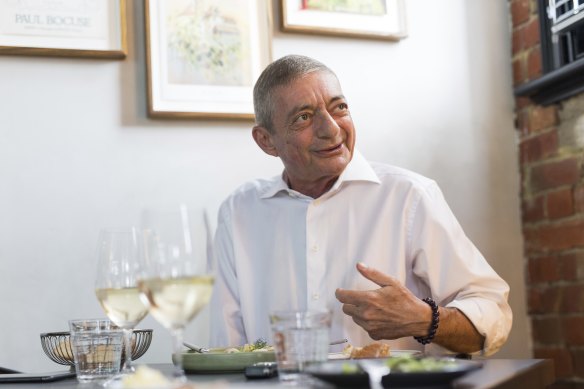
William Mora looks back on his baptism of fire in the restaurant business: “At 17 or 18, I had 35 staff.″Credit: Paul Jeffers
The middle child is William, whose eponymous gallery continues his father’s tradition of showcasing talent in the visual arts. He has worked with Indigenous greats including Ginger Riley Munduwalawala and Queenie McKenzie and represents the estate of Paddy Bedford; he was one of the first gallerists to host solo shows by Indigenous artists, as opposed to showing by community.
Warm and charming, the 67-year-old worked for a decade with his father at Tolarno Galleries, first in the city and then in South Yarra. While at the latter, they would lunch every Monday “without exception” at nearby France Soir.
We’re honouring that tradition, dining at Frederic’s in Cremorne, a French bistro-style restaurant run by Jacques Reymond’s children. Minutes from William Mora Galleries, it is humming this weekday lunchtime, with diners celebrating newfound freedom after yet another lockdown.
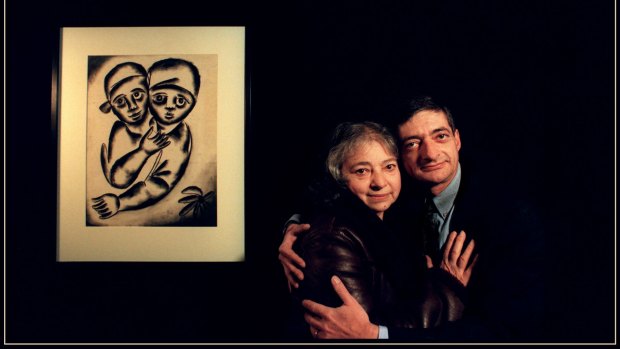
Mirka and William Mora with her work “Young Lovers”, 1961. Credit: Fairfax
It’s a far cry from the Melbourne Georges and Mirka found when they emigrated in 1951: an inward-looking, ultra-conservative city, far from the bohemian Paris they’d left. “The irony was my father was offered a better job in Saigon, which was still a French colony then, but my mother was set on Melbourne; she thought it sounded very exotic. Of course, they got here to discover it was a bit of cultural wasteland,” Mora says.
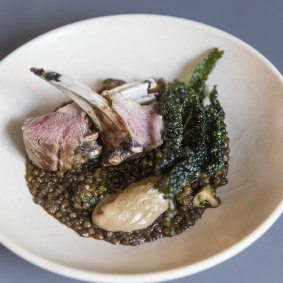
Frederic’s lamb roast with kale and puy lentils.Credit: Paul Jeffers
Coffee was not yet available; Georges was appalled by the alternative, chicory essence, made from coffee beans and caramel. He proceeded to open Mirka Cafe, the first restaurant licenced to serve alcohol in the city - and to have an espresso machine. It proved a saving grace for the young couple, bringing them together with like-minded people. They would soon meet John and Sunday Reed and artists such as Sidney Nolan, Arthur Boyd and Charles Blackman, who, along with Mirka, would become known as the Modernists. The cafe would also double as a gallery, showing work by John Perceval and Joy Hester.
Once we order, octopus then roast lamb for him, snapper ceviche and octopus for me, and a glass of house pinot gris each, Mora recalls making pocket money as a kid working as a waiter for his parents, polishing 50-odd glasses and serving wine.
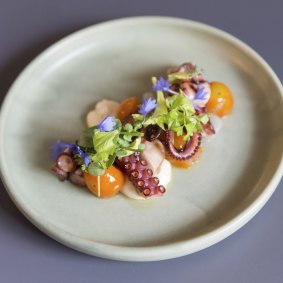
The octopus with pickled tomatoes at Frederic’s is pretty as a picture.Credit: Paul Jeffers
“When my parents separated, [Georges] said to me, ‘Your mother is moving out, I am going overseas, you run the restaurant.’ I’d just matriculated, and thought, ‘Well this sounds more interesting than going to university’. So, at 17 or 18, I had 35 staff. It was unbelievable.”
It sounds like a crazy baptism by fire. “We grew up in the restaurant, but yeah, I was shitting myself, absolutely,” he says with a laugh. “My father came back a couple of months later, after Mirka had moved out, and said, ‘This is all going well’, and he went back [overseas] again.”
Having such an outlandish mother, especially as a self-conscious tween, was not always ideal. “Growing up with Mirka was very hard, because she loved to embarrass people and was notorious for flashing her boobs. Whenever there was a cake she would plunge her hand into it,” he says.
The children were aware that at any moment, anything could happen, and he sometimes thought, “Here we go, Mum’s going to jump on the table and do the can-can.”
Mirka made her own clothes, sometimes fashioning a blanket into an outfit by cutting a hole in the middle and tying a ribbon around it. “She looked really stylish but it was only into our teens that we started to appreciate how wonderful her difference was.”
At one stage, he and Tiriel “dragged her along to Myer and made her buy a twinset to wear when she picked us up from school”.
Mora tells these stories lovingly, aware of just how extraordinary his mother was. He sees her joie de vivre and lack of inhibition, now so celebrated, through very different eyes to his childhood self.
Other issues posed challenges for the Mora children. Georges worked long hours in the restaurant and was a wanderer (“His idea of a holiday was to leave the family at home and go travelling”) and his mother prioritised her work. “Mirka put her art first, she was very open about that. Now, she is such a beacon to joy and exploration of life. All of that was obviously part of dealing with the horrific experience of escaping the Holocaust.”

The Mora family in Mirka’s Studio at Tolarno in 1967. From left to right: Philippe, Mirka, William, Tiriel (on ladder) and Georges
Having narrowly avoided being sent to Auschwitz, Mirka’s family spent three years of the war hiding in the woods in France. At the same time, Georges worked with the French Resistance, smuggling orphaned Jewish children to safety, at times disguised as a nun. The couple met in Paris and married in 1947.
Mora says his parents rarely spoke about the atrocities of war, focused instead on carving out a new world. The eyes that dominate so many of Mirka’s works are inspired by those looking out from the trains that carried the Nazis’ victims to their fate. Her work is a joyous celebration of humanity, a clear rejection of such evil.
Researching MIRKA, an exhibition now showing at the Jewish Museum in St Kilda, which he co-curated, Mora unearthed a treasure trove of material from his mother’s home. “Basically every artist in Australia in the Moderns and the Sydney school had written letters to Mirka.”
An incredible hoarder, she had saved work, diaries and all manner of correspondence. Her son used to warn visitors that they would end up with oil paint on their jackets from works stacked up around the place. Mora hopes to convert her Richmond apartment – which includes her studio – into a museum of sorts, so school groups and others can visit and learn more about her extraordinary practice.
Since 1999, his mother lived beside him and his wife Anna Mortley, also manager of Mora Galleries, and then their nine-year-old daughter, Carlotta; he has two children from his first marriage, Fred, 29, and Lily, 31. Continuing family tradition, Lily recently set up Sunday Salon for emerging artists.
As we tuck in to dessert, a classic souffle for him, and my mousse which riffs on a Cherry Ripe, two dessert wines arrive, courtesy of nearby diner Michael Bartlett, chairman of the Australia Club. In a role seemingly at odds with his bohemian upbringing, Mora sits on the club’s art committee. He curates a show a year for them, including a teaming of Fred Williams with Paddy Bedford and more recently Mirka.
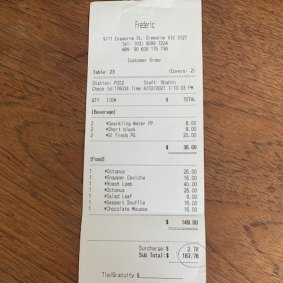
Receipt for lunch with William Mora at Frederic’s.
Since his mother’s death in 2018, Mora has devoted much time and energy to ensuring her legacy continues. Three big museum shows this year have Mirka at their heart: the Jewish Museum exhibition, which tells her life story, starting with her childhood in France; Know My Name, a celebration of 100 years of female artists at the NGA in Canberra; and House of Ideas, Modern Women, now showing at Heide. Opening next week at Mora Galleries is Mirka Mora - A Rare Selection of Early Charcoals, Pastels and Neon Inks.
“Her personality was so much larger than her work,” says Mora. “People often bought her work getting a bit of Mirka,” he says. “Now that she has been passed for two years, suddenly the work takes on a new profundity. People look at it differently, somehow you just see the work now, not the personality so much.”
MIRKA is at the Jewish Museum until December 19; House of Ideas: Modern Women is at Heide until October 31; Know My Name Part Two is at the NGA until January 26, 2022.
The bill, please
Frederic Bistro, 9-11 Cremorne St, Cremorne; 9089 7224; Mon-Fri noon-11pm; Sat 5pm-11pm; Sun noon-4.30pm.